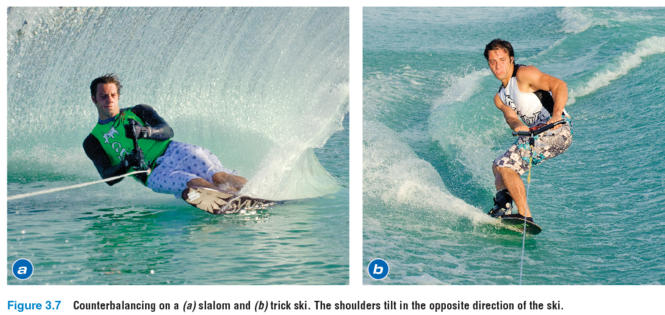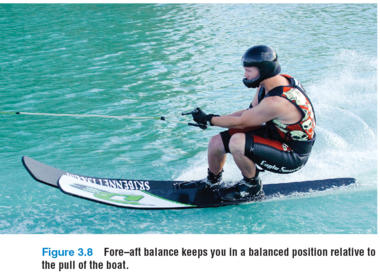Balancing With Counter and Fore-and-Aft Movements
Brent Larsen, coach and father of the world record–setting trickers Britt and Tawn, emphatically believes that water skiing should be defined as balance in motion. Balance is the skill required to keep the body in equilibrium when it is acted on by external forces; it directly affects our ability to perform other movements properly. Balance addresses how the body’s central mass moves in dynamic relation to more specialized peripheral movements of the extremities—the hands, arms, legs, ankles, head, fingers, and toes. Other forces that affect balance may be the result of deliberate actions on the skier’s or boarder’s part (tipping, counteracting), or a reaction to disturbances (change in boat motion, rope stretch, ski setup, and wind and water conditions).
The two types of balancing movements are counterbalancing and fore–aft balancing. Both of these are initiated by, and interact with, tipping the skis or board as well as how the entire foot is positioned in relation to the surface. The need to sense the sometimes very subtle changes in position is why good foot beds and good foot contact with the ski or board are so critical. Either a forward or backward weight shift (weight on your toes or heels) or side-to-side movement (weight on the inside or outside of your foot) changes your balance point in relation to your upper body. Feeling and working the entire foot and positioning your upper body in relation to those movements are balancing movements.
Counterbalancing is simply the side-to-side tilting of the upper body at the waist in the direction opposite the turn or change in direction as shown in figure 3.7. If you have trouble turning with speed or keeping the skis or board on edge through the turn, you should concentrate on learning how to make proper counterbalancing movements. The signature of good counterbalancing is a still or calm upper body with the hips, legs, knees, and ankles moving side to side under the torso.

Fore–aft balance movements are in response to the location of the hips relative to the feet. Think of your feet on the skis or board as being between your hips and the boat (see figure 3.8). This position or body alignment requires an overall body tension. A break down in that alignment and tension is often one of the first signs that you are getting tired. Rather than focusing on moving the hips to maintain fore–aft balance, focus on moving the feet. Fore–aft balance is most critical during the initiation of a change of direction and just before the rope is reloaded and stretched. The movement is initiated by the foot nearer the boat and acts to center the body over the skis or board. Fore–aft movement combined with flexing and extending create what is called upper-body/lower-body separation in snow skiing; the same principle applies on the water. Keep your upper body calm and keep your movement below the hips.
